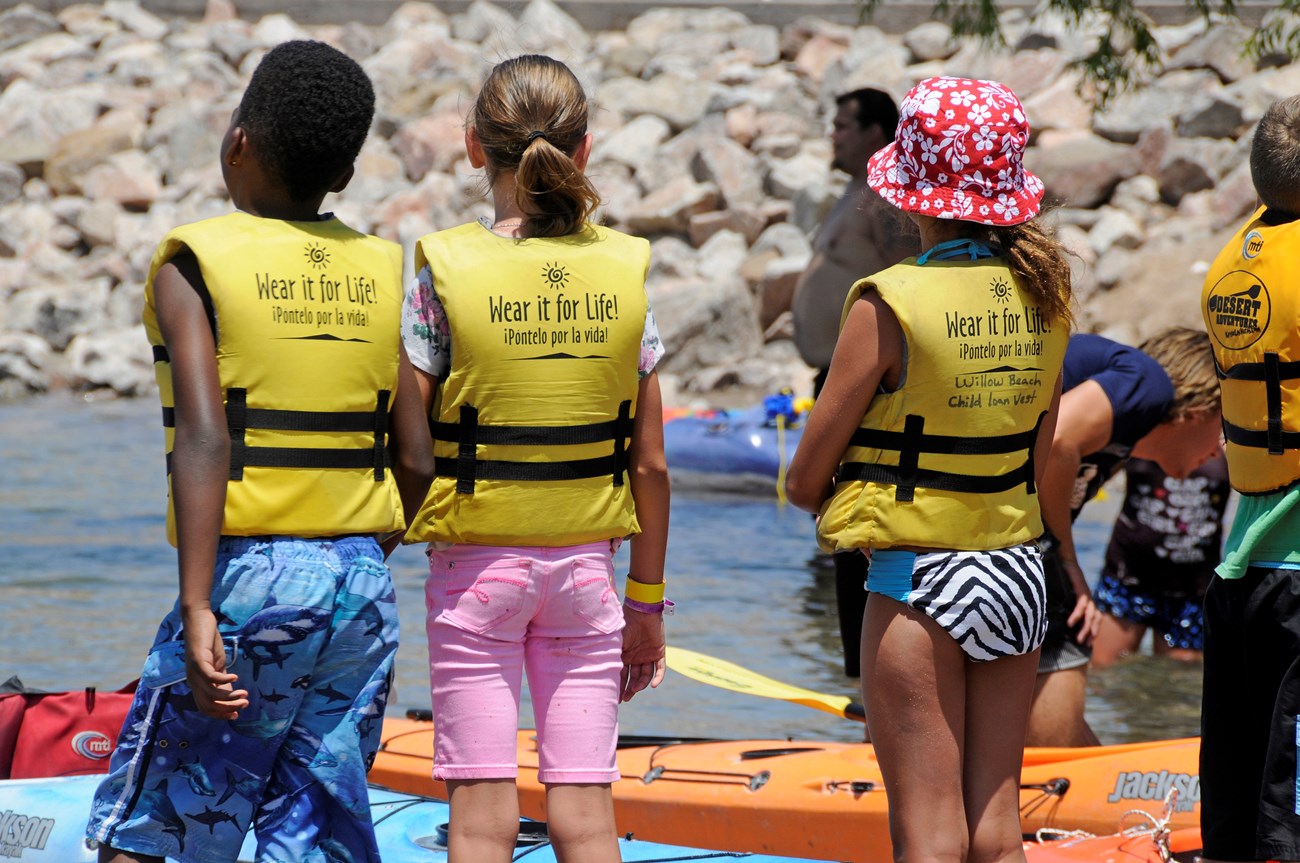Last updated: May 3, 2024
Article
Stay Afloat: Always Wear a Life Jacket

Chelsea Kennedy, NPS
Drowning is the second leading cause of unintentional deaths reported in national parks. Yet, nearly all are preventable. It is important to understand that recreating in natural bodies of water like rivers, lakes, and oceans is very different from recreating in a swimming pool.
-
Water currents can tire you out and sweep you away
-
Distance across water is greater than it looks
-
Cold water can shock your body and make it difficult to swim
-
Water depth can suddenly change to above chin level
-
Underwater hazard like trees and rocks can trap you and keep you from swimming back to shore
Wearing a life jacket can save your life and help bring everyone home after a fun day in the water by:
-
Preventing drowning
-
Keeping you afloat if you get tired
-
Giving you time while awaiting rescue
All water users (swimmers, boaters, anglers, etc.) should wear a life jacket. Even strong swimmers have drowned or needed to to be rescued because they were overcome by the water. Simply carrying a life jacket is not enough as you may not have time to put it on if you encounter a water hazard, slip while fishing, or fall out of your vessel. Don’t take the chance!
Have the right life jacket. There are 3 basic kinds of life jackets that can be selected for your activity and swimming skill level. It is important to understand the types of jackets and when they should be used:
-
Inherently Buoyant (Primarily Foam): These low-maintenance life jackets are both comfortable and reliable and come in wearable and throwable fashions.They are designed for swimmers and non-swimmers, and come in Adult, Youth, Child and Infant sizes.
-
Inflatable: Inflatable life jackets are lightweight and comfortable to wear. They are only available in wearable, Adult sizes. This kind of flotation should NOT be worn by poor or non-swimmers.
-
Hybrid (Foam and Inflation): These reliable jackets are available in Adult, Youth, Child and Infant sizes and wearable styles. They are recommended for both swimmers and non-swimmers, and some are designed for water sports.

NPS Photo
Your life jacket must be:
- US Coast Guard-approved (check the label)
- In good and serviceable condition. You should check the wear and buoyancy of your life jacket every year.
- The right type of life jacket for your activity and the right size for you.
- Properly stowed onboard--However, you should be wearing it at all times.
Know your swimming skill level and pick the appropriate life jacket. Be realistic and assess your swimming skills. This will help determine which life jacket is best for you.
Try on and test the fit of your life jacket. Your life jacket should fit comfortably snug. To quickly check the fit, fasten and secure all of the straps and raise your arms. Your vest should stay and not ride up. You can also have someone lift the jacket up at your shoulders; it should not go above your ears.
Be prepared for an emergency. Choose a brightly-colored life jacket that is highly visible and easy for others to spot. It is also a good idea to attach a whistle and an emergency light to your vest, just in case you accidentally fall into the water or get caught in the current. It could help search and rescuers find you.

NPS Photo
Borrow a life jacket. Some parks have life jacket loaner programs that offer free life jackets to borrow while you are in the park. Just grab them before you go, and return them for others to use before you leave! Follow the fit instructions above so you find the right one for you.
Life jackets are required for boating. Federal law requires that you have a US Coast Guard-approved, wearable life jacket for each person on board the vessel. Boats that are 16 feet or longer, excluding canoes and kayaks, must also have a throwable ring buoy.
When boating, children under 13 years must wear a life jacket by federal law if the vessel is moving; states may have additional requirements. We recommend that no matter what your age, you should always wear a life jacket when you are on the water.
Check park rules and regulations. Parks may have their own rules and regulations on when life jackets are required in addition to state and federal requirements. For example, Upper Delaware Scenic & Recreational River requires all boaters to wear life jackets when the river height is above 6-feet and from November 1 to April 1st. You can be cited for not wearing a life jacket during these conditions.
Learn more about life jacket wear and how you can prepare your vessel if you plan to paddle, float, or boat in the park.
Learn more about water hazards and how they can affect you when you are in or on the water.
Plan and prepare for your trip with help from the NPS Trip Planning Guide and Junior Ranger Park Explorer. Learn more about your Health & Safety in national parks.
Check to see if your park will be hosting any Junior Ranger activities or water safety events!
